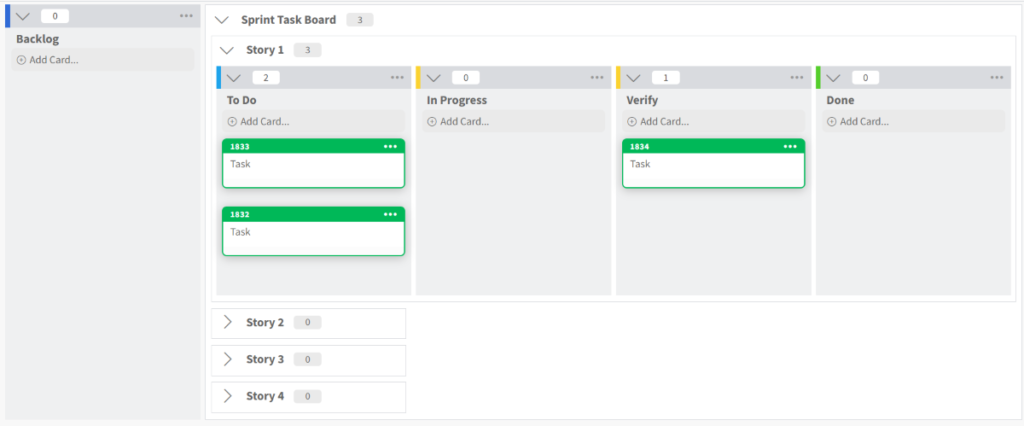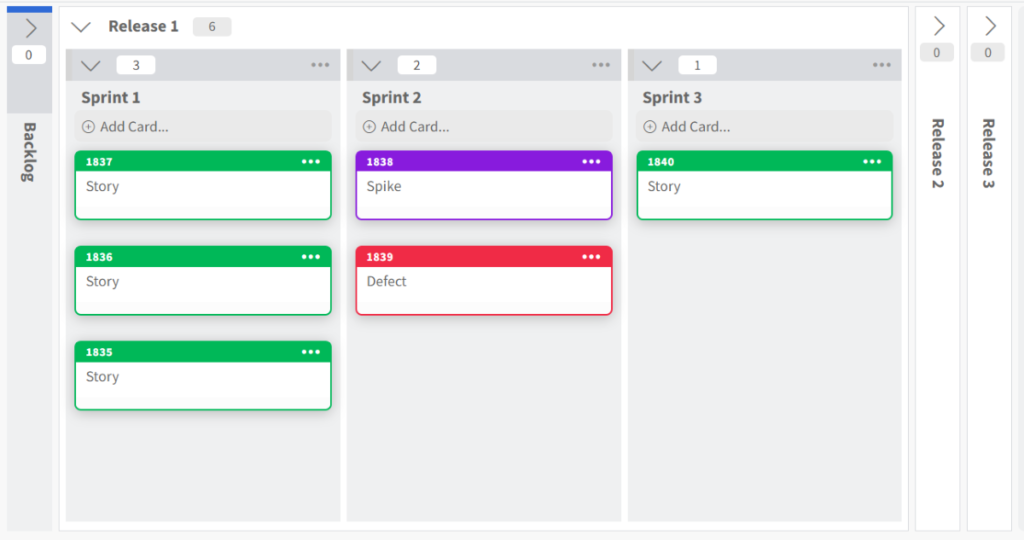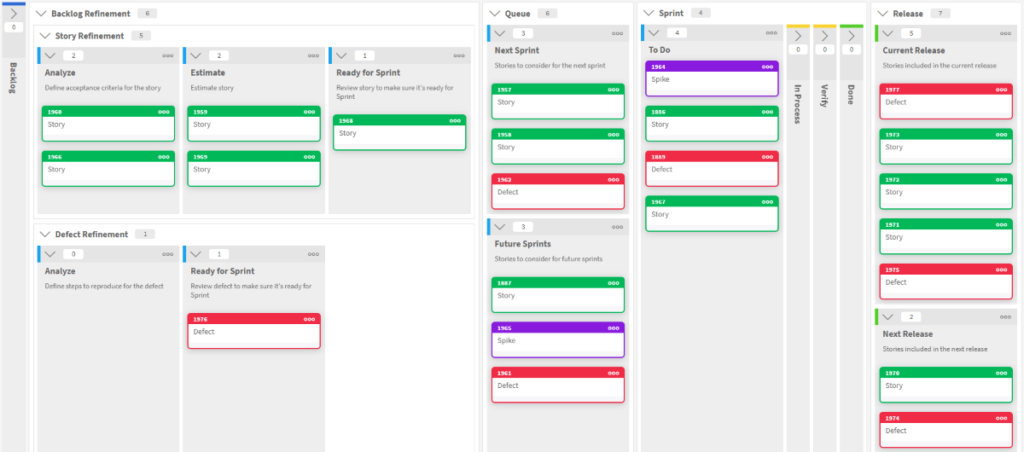Scrum is one of the many Agile methodologies that can leverage Kanban boards to visualize the work. To support Scrum organizations, we have created multiple Kanban board templates that can be used independently, or in collaboration moving or connecting cards across multiple boards in Kanban Zone. These include a number of Scrum Board templates.
Scrum Task Board
Once the Scrum team has completed their sprint planning event, the outcome is to publish the content of the sprint on a Scrum board. Each story committed within a sprint is broken down into tasks and these tasks must flow from “To Do” to “Done” during the sprint. This board is actually a Kanban board made of the following columns: To Do, In Progress, Verify and Done.
The Scrum board template above uses lanes to represent each story in the sprint and the tasks associated with that story flow within that lane. Because Kanban Zone boards are created using containers, each of these containers can provide helpful information on the board. For example, each story lane (container) can count the number of tasks for that story. You can also collapse/expand containers to see only what matters to you.
Scrum Release Plan
Scrum does not prescribe any additional level of planning above the Sprint, but in eXtreme Programming (XP) it’s common to have another planning level above the iteration called Release planning. Since Scrum teams often blend XP practices to improve their engineering practices, we have created another Kanban board template to visualize multiple sprints within a release.
The Scrum board template above uses top-level columns to visualize/plan releases and within each of these release columns, there are multiple sprints that hold the cards to represent the work to be planned for each sprint. Each release can contain any number of sprints.
- If you plan your release to be feature driven (end when the feature is completed), then create the planned number of sprints to achieve that goal.
- If you plan your release to be date driven (end on a specific date), then create the planned number of sprints available before that date.
If your organization conducts release planning or big room planning sessions to discover your work for more than a single sprint, then this Scrum board template will let you plan your work within each release and sprint. Planning too far ahead will cause you to most likely have to move workaround, but this template will help you see the big picture.
Scrum Backlog Flow
One of the reasons we love Kanban is that you can visualize your entire process flow on a single board. In Scrum, the product backlog is a separate artifact from the sprint backlog or another way to say it, is that the sprint backlog is a subset of the product backlog. In the Scrum board template below, we combine the end-to-end process of a Scrum team on a single Kanban board.
The Scrum board template above represents the way a Scrum work item (story, defect, or spike) can flow from ideation to deployment.
Backlog Refinement
The first section takes the stories from the backlog and refines them. We labeled that first step of the process the Backlog Refinement column that has two horizontal lanes to differentiate between the flow of a story/spike and a defect.
- Stories require acceptance criteria and should get estimated.
- Defect require steps to reproduce and our mind should not get estimated because they are often needles in a haystack.
Note: Estimating defects in Lean Thinking can be considered as wasteful because providing the estimate may require a developer to do significant research that can coincide with actually solving the defect. This distraction can be viewed as wasteful within Scrum because it pulls a developer away from their current sprint to work on something that is not included in their current sprint.
Queue
Once the work item is ready for a sprint, the work item is queued into the current or next sprint. In this template, we only look at two sprints, but you can create more sprints. The reason for keeping it at two sprints is to keep flowing immediate high-value cards on this board and not focus on any low-value cards. If the flow of cards “Ready for Sprint” is higher than the amount of cards that can be handled by 2 sprints, then we would suggest adding an extra sprint, or an overflow sprint for future sprints. The goal is to stay Just-In-Time (JIT) because if too many cards accumulate, they might become stale and need to be re-worked, which again would be wasteful.
Sprint
This section of the Scrum board is your typical Scrum task board. We kept the template simple, but if you are going to use this template and leverage a more defined Kanban end-to-end process, you might want to consider improving these columns to match the way your team works best to flow their cards.
Release
Because the work will ultimately need to be released, we again track only two cycles (current and next). This Scrum board template is meant to stay as simple as possible, but accumulating work in releases that don’t get deployed in a timely manner will negatively impact your overall flow. In this case, we do recommend that you ship your current release ASAP so that you don’t lose your speed to market gained from doing Scrum in the previous section of your Kanban board.
The board can add more columns to the right to track what happens after your work is potentially shippable in Scrum. As always we welcome your feedback to keep improving existing templates or create new ones.
Kanban Zone can also leverage Kanban metrics to track the cycle time of each card on the board and the final throughput for the sprint. Other features in Kanban Zone like single card owner can help with accountability without preventing collaboration on the cards by using watchers and all the interactions available within a card (comments, checklist, attachments, links, etc…).






